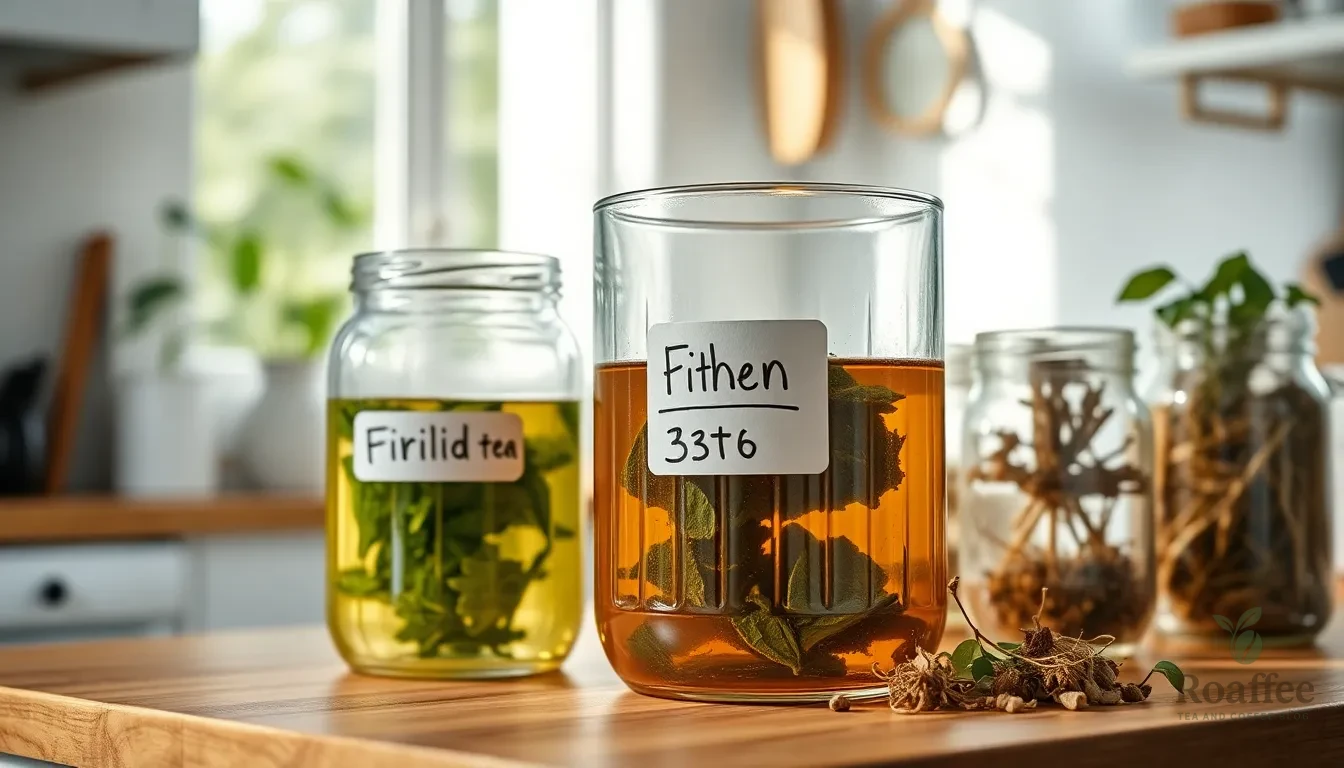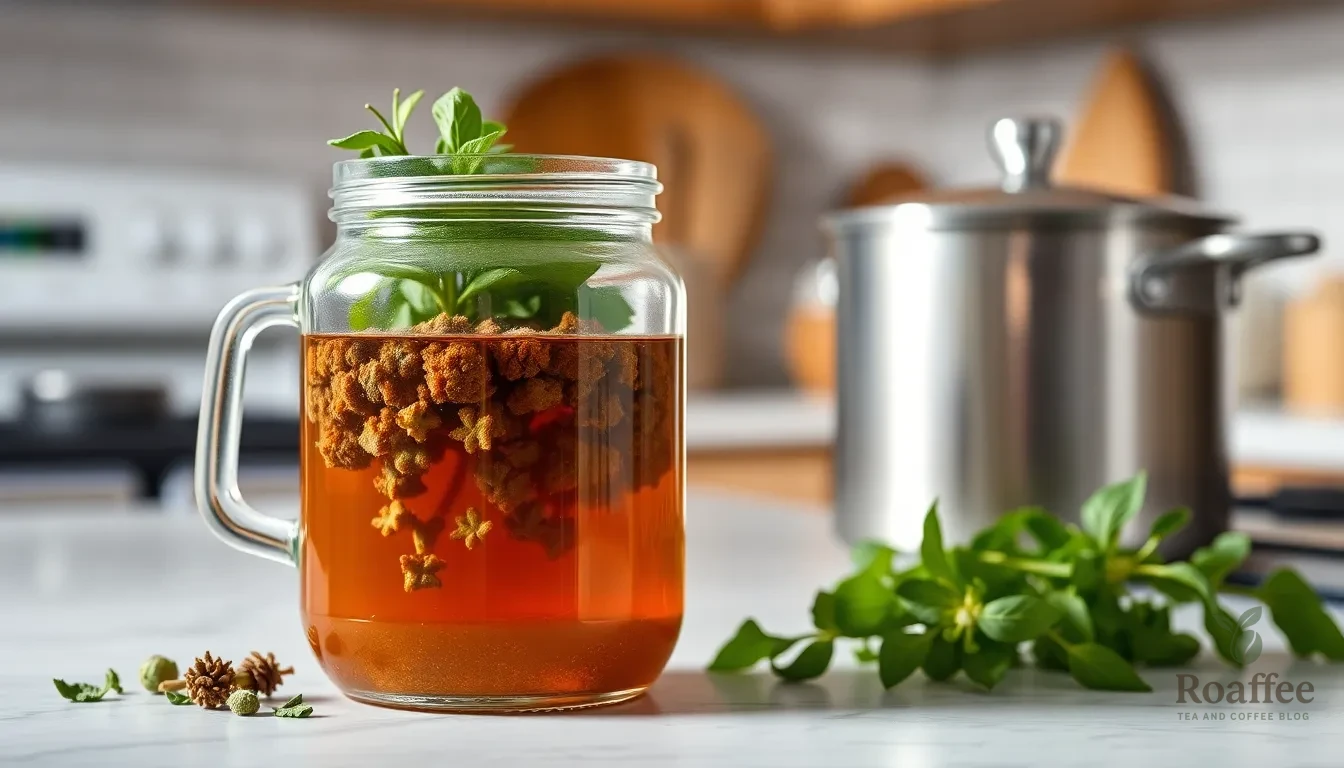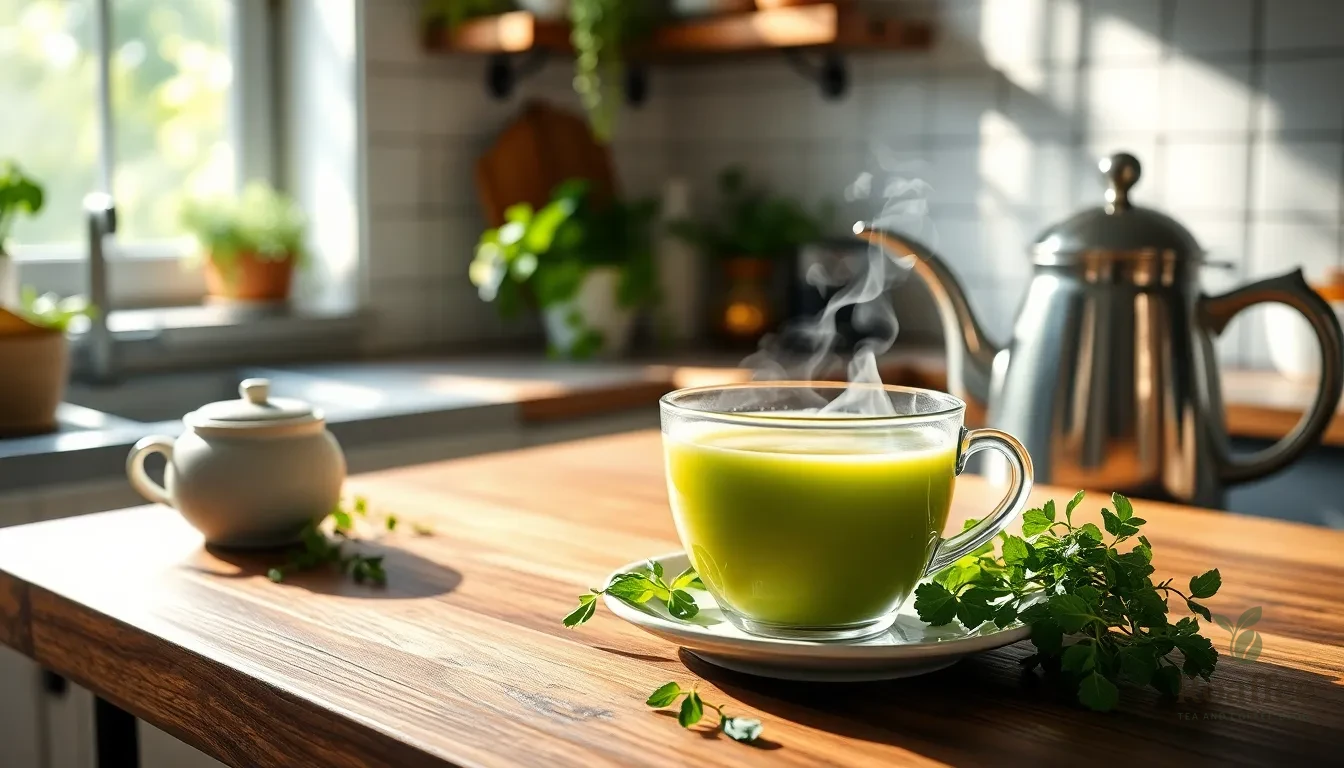Managing fibroids naturally has become a priority for many women seeking gentle yet effective alternatives to traditional treatments. We’ve discovered that the right combination of herbs can create a powerful healing tea that supports your body’s natural balance while potentially reducing fibroid symptoms.
Our carefully crafted fibroid tea recipe combines time-tested herbs known for their anti-inflammatory and hormone-balancing properties. This therapeutic blend isn’t just another herbal tea – it’s a targeted approach to wellness that women have relied on for generations. The ingredients work synergistically to support reproductive health while providing a soothing daily ritual.
We’re excited to share this simple yet potent recipe that you can easily prepare at home. With just a few natural ingredients and minimal preparation time, you’ll have a delicious tea that supports your wellness journey while offering the comfort of knowing you’re taking proactive steps toward better health.
What You’ll Need for This Fibroid Tea Recipe
Our carefully crafted fibroid tea recipe requires just a handful of powerful herbs that work synergistically to support reproductive health. We’ve selected these ingredients based on their proven anti-inflammatory properties and hormone-balancing effects.
Essential Herbs and Ingredients
For the Base Tea Blend:
- 1 tablespoon dried red raspberry leaf
- 1 tablespoon dried nettle leaf
- 1 teaspoon dried vitex (chaste tree berry)
- 1 teaspoon dried dandelion root
- 1/2 teaspoon dried ginger root
- 1/2 teaspoon dried turmeric root
- 2 cups filtered water
- Raw honey to taste (optional)
Equipment Needed:
- Large glass jar or airtight container for storage
- Fine mesh strainer or cheesecloth
- Medium saucepan
- Measuring spoons
- Wooden spoon for stirring
Quality and Sourcing Considerations
We recommend purchasing organic herbs whenever possible to ensure maximum potency and avoid pesticide residues. Many health food stores carry these herbs in bulk bins, which allows for fresher ingredients and better cost control. Online herbal suppliers also offer high-quality dried herbs that maintain their therapeutic properties.
Fresh herbs can substitute for dried ones using a 3:1 ratio, though dried herbs provide more concentrated benefits and longer shelf life. Store your herb blend in a cool, dark place in an airtight container to preserve freshness for up to six months.
Preparation Time and Yield
This recipe yields approximately 4 servings when prepared as a concentrated tea blend. Total preparation time takes about 20 minutes, including steeping time. We suggest making larger batches of the dry herb mixture to have on hand for convenient daily preparation.
Ingredients

Our fibroid tea recipe combines scientifically-backed herbs with traditional remedies to create a powerful blend for uterine health. We’ve carefully selected each ingredient based on research showing their effectiveness in supporting fibroid management.
Primary Herbs
- 2 teaspoons green tea leaves (or 2 green tea bags) – Contains EGCG, proven to reduce fibroid size and symptom severity
- 1 teaspoon dried guizhi fuling – Traditional Chinese herb for hormone balance and uterine health
- 8 oz filtered water – For optimal extraction of beneficial compounds
Supporting Ingredients
- 1/2 teaspoon ground turmeric – Provides curcumin to limit fibroid growth and support liver detoxification
- 1/4 teaspoon dried monk’s pepper (chasteberry) – Helps manage heavy bleeding by modulating hormone levels
- 1/4 teaspoon resveratrol powder – Plant polyphenol offering anti-inflammatory and antioxidant properties
Optional Additions
- 1 teaspoon raw apple cider vinegar – Supports body detoxification and promotes uterine health
- 1-2 teaspoons raw honey – Natural sweetener to improve taste
- Vitamin D supplement – When combined with green tea extract, enhances fibroid size reduction
| Herb Component | Active Compound | Primary Benefit |
|---|---|---|
| Green Tea | EGCG | Reduces fibroid size and symptoms |
| Guizhi Fuling | Traditional blend | Hormone balance and uterine health |
| Turmeric | Curcumin | Limits fibroid growth |
| Monk’s Pepper | Vitex compounds | Manages heavy bleeding |
Equipment and Tools

Preparing our fibroid tea requires minimal equipment that most home cooks already have in their kitchens. We need a teapot or medium saucepan to boil water for steeping our therapeutic herbs. A fine-mesh strainer becomes essential when using loose leaf tea to ensure our finished tea is smooth and free from plant particles.
For those choosing to incorporate fresh ginger or cloves into their fibroid tea blend, a mortar and pestle helps crush these ingredients to release their active compounds. This traditional tool maximizes the anti-inflammatory benefits we seek from these powerful additions. Kitchen shears can serve as an alternative for chopping fresh herbs into smaller pieces.
We recommend using glass or ceramic cups for serving our fibroid tea rather than plastic containers. These materials preserve the delicate flavors and beneficial compounds without introducing unwanted chemicals. A digital kitchen scale proves helpful for measuring precise amounts of dried herbs, especially when preparing larger batches.
| Equipment | Purpose | Alternative Option |
|---|---|---|
| Teapot or saucepan | Boiling water for steeping | Large mug with hot water |
| Fine-mesh strainer | Removing loose tea particles | Tea infuser or cheesecloth |
| Mortar and pestle | Crushing ginger and cloves | Kitchen knife for chopping |
| Glass or ceramic cups | Serving the finished tea | Stainless steel mugs |
| Digital kitchen scale | Measuring dried herbs | Measuring spoons |
Storage containers with tight-fitting lids become important for maintaining the potency of our herb blends. We store our prepared tea mixtures in dark glass jars to protect them from light exposure that can degrade the beneficial compounds. A tea timer or smartphone helps us achieve the optimal steeping time of 3-5 minutes for maximum EGCG extraction from green tea leaves.
Instructions

Now that we have all our ingredients and equipment ready, let’s walk through the step-by-step process for creating our therapeutic fibroid tea. These methods will help us extract the maximum benefits from our carefully selected herbs.
Prep the Herbs
We start by preparing our herb mixture using a dry blender to powder the herbs thoroughly. This method ensures maximum extraction of active compounds from ingredients like chaste tree and milk thistle. For those preferring a gentler approach, we simmer 1 tablespoon of chaste tree in 1 quart of water for 5-10 minutes before removing from heat. After simmering, we add 1 heaping tablespoon of milk thistle and allow the mixture to steep for 30 minutes. Our powdered herb preparation requires 1 teaspoon of powder per cup of boiling water for optimal potency.
Combine the Ingredients
We measure our powdered herb mix carefully, using the recommended 1 teaspoon per cup of boiling water ratio. For the chaste tree and milk thistle infusion, we strain the tea after the 30-minute steeping period. Optional flavor enhancers can be added at this stage, including 1 tablespoon molasses, 1 teaspoon cinnamon, and a wedge of lemon to 1 cup of boiled water. Green tea leaves rich in EGCG can be incorporated for additional anti-fibroid benefits, providing scientifically backed support for reducing fibroid formation.
Brewing Process
We pour boiling water over our powdered herbs and stir well, allowing the mixture to cool slightly before consuming. For our chaste tree and milk thistle combination, we follow the simmering and steeping process outlined above. Green tea preparation requires brewing the leaves in hot water for 3-5 minutes to properly extract the beneficial EGCG compound. Each brewing method maximizes the extraction of therapeutic compounds exact to fibroid management.
Straining and Serving
We strain our tea to separate herbs from liquid, except when consuming powdered herbs where both components provide therapeutic value. Our fibroid tea should be served warm for optimal absorption of active compounds. The recommended dosage is 1 cup up to 4 times daily, with treatment duration varying from 6-10 weeks for powdered herbs to 3-6 months for chaste tree and milk thistle infusions. Studies suggest combining 800 mg of green tea EGCG with 5,000 IU Vitamin D daily shows promise in reducing fibroid formation and growth.
Directions for Daily Use

We’ve established the ideal preparation method for our fibroid tea, and now we need to focus on the optimal consumption schedule. Following proper dosing guidelines and timing ensures maximum therapeutic benefits while supporting your body’s natural healing processes.
Recommended Dosage
We recommend drinking 3 to 5 cups of green tea daily to achieve the therapeutic levels studied in clinical research. This amount provides approximately 800 mg of EGCG daily, which corresponds to the dosage evaluated in fibroid management studies. Each cup should contain 1 teaspoon of green tea leaves or 1 green tea bag steeped in 8 ounces of hot water for 3-5 minutes.
For enhanced fibroid management, we suggest combining your daily tea consumption with 5,000 IU of Vitamin D daily as research indicates this combination may provide superior results. Start with 2-3 cups daily during your first week to assess your body’s response to the caffeine content before increasing to the full recommended amount.
Best Times to Drink
We’ve found that timing your tea consumption strategically maximizes benefits while minimizing potential side effects. Drink your first cup in the morning to take advantage of green tea’s energizing properties and support your body’s natural detoxification processes. Your second and third cups work best in the early afternoon between meals to maintain consistent EGCG levels without interfering with sleep patterns.
Avoid consuming fibroid tea within 4 hours of bedtime since the caffeine content may disrupt your sleep quality. We recommend spacing your cups throughout the day rather than drinking them consecutively to maintain steady antioxidant levels in your bloodstream.
Duration of Use
Clinical studies demonstrate that important benefits appear after 3 months or longer of consistent daily consumption. We observe the most substantial improvements in fibroid volume reduction and symptom severity when women maintain their tea routine for extended periods. Research reports a mean 32.6% decrease in fibroid volume among participants who consumed green tea regularly for several months.
Long term use may be beneficial for preventing fibroid growth or recurrence after medical treatment. We recommend establishing this tea routine as part of your daily wellness practice rather than a short term intervention. Monitor your progress with regular medical checkups to track improvements in fibroid size and related symptoms like heavy bleeding or anemia.
Storage Instructions

We understand that proper storage is crucial for maintaining the potency and effectiveness of your fibroid tea. Brewed tea can be stored in a covered container in the refrigerator for up to 3 days while preserving its beneficial compounds. When reheating stored tea, we recommend warming it gently without bringing it to a full boil to maintain the antioxidant properties that make this tea so effective.
Storing Brewed Tea
Fresh Storage Guidelines:
- Store brewed tea in glass or ceramic containers with tight-fitting lids
- Refrigerate immediately after cooling to room temperature
- Label containers with preparation date for easy tracking
- Keep away from strong-smelling foods that might affect flavor
| Storage Method | Duration | Temperature | Container Type |
|---|---|---|---|
| Refrigerated brewed tea | 3 days | 35-40°F | Glass or ceramic with lid |
| Room temperature | 4-6 hours | 68-72°F | Covered container |
| Frozen tea cubes | 3 months | 0°F | Ice cube trays |
Preserving Dried Herb Blends
We store our dried herb mixtures in airtight containers away from direct sunlight and heat sources. Glass mason jars work exceptionally well for maintaining the integrity of ingredients like green tea leaves, vitex, and dandelion root. Each herb blend maintains its therapeutic properties for 12 to 18 months when stored properly in a cool, dry environment.
Reheating Guidelines
When warming refrigerated fibroid tea, we use gentle heat to preserve the EGCG content that research shows reduces fibroid volume by 32.6% after consistent use. Pour the chilled tea into a saucepan and warm over low heat until steam begins to rise. Avoid microwave heating as it can create hot spots that destroy beneficial compounds.
Batch Preparation Storage
We often prepare larger quantities of our fibroid tea blend to save time during busy weeks. Store pre-mixed dry ingredients in separate labeled containers, keeping powdered herbs like turmeric and ginger in small glass jars. This method allows you to prepare single servings quickly while maintaining the freshness of each ingredient.
Make-Ahead Tips

Preparing larger batches of fibroid tea saves time and ensures consistent therapeutic benefits throughout the week. We recommend brewing a concentrated version using double the herb amounts with the same water quantity for a more potent base that can be diluted as needed.
Batch Brewing Strategy
Brew a full week’s supply by preparing 4-6 cups of concentrated tea at once. Store this concentrated blend in glass containers in the refrigerator for up to 24 hours to maintain maximum EGCG potency. Research shows that freshly brewed green tea provides optimal therapeutic compounds for fibroid management.
Optimal Storage Methods
| Storage Method | Duration | Temperature | Container Type |
|---|---|---|---|
| Refrigerated brewed tea | 24 hours | 35-40°F | Glass jar with lid |
| Concentrated tea base | 3 days | 35-40°F | Glass container |
| Dry herb blend | 6 months | Room temperature | Airtight container |
Store your concentrated tea base in the refrigerator using glass containers rather than plastic to preserve the delicate antioxidants. Mason jars work exceptionally well for this purpose and prevent any chemical leaching that could compromise the tea’s therapeutic properties.
Reheating Guidelines
Reheat gently without boiling to preserve the beneficial EGCG compounds that contribute to the 32.6% reduction in fibroid volume shown in clinical studies. We suggest warming individual servings in a small saucepan over low heat or using a microwave at 50% power to avoid destroying the active compounds.
Preparation Scheduling
Plan your tea preparation around your daily routine by brewing fresh batches every morning or evening. This approach ensures you consistently receive the recommended 800 mg daily equivalent of green tea extract through 3-5 cups of properly prepared tea. Morning preparation allows the tea to cool slightly before your first serving while maintaining peak potency throughout the day.
Variations and Substitutions

We understand that every woman’s needs and preferences are different when it comes to managing fibroids naturally. Our fibroid tea recipe can be easily adapted to accommodate various dietary restrictions and desired potency levels.
Caffeine-Free Options
Green tea naturally contains caffeine which may not be suitable for everyone, particularly those sensitive to stimulants or pregnant women. Decaffeinated green tea provides a viable alternative that may still offer therapeutic benefits, though research on its effectiveness for fibroid management remains limited compared to regular green tea.
Herbal tea substitutes can replace green tea entirely for those seeking completely caffeine-free options. Red raspberry leaf serves as our primary caffeine-free base, offering uterine-supportive properties without stimulant effects. Nettle leaf provides another excellent foundation with its anti-inflammatory compounds and mineral content.
We recommend brewing 2 teaspoons of red raspberry leaf with 1 teaspoon of nettle leaf in 8 ounces of hot water for 10-15 minutes. This combination creates a mineral-rich base that supports reproductive health while remaining completely caffeine-free.
Evening consumption becomes possible with caffeine-free versions, allowing you to enjoy the therapeutic benefits throughout the day without affecting sleep patterns. Many women find that drinking caffeine-free fibroid tea before bedtime helps with relaxation and overnight healing processes.
Stronger Blend Modifications
Creating a more potent fibroid tea involves strategic adjustments to our base recipe while maintaining safety and palatability. Increasing green tea concentration represents the most direct approach to improving therapeutic effects, given that studies show effectiveness with approximately 800 mg of green tea extract daily.
We suggest doubling the green tea leaves from 1 teaspoon to 2 teaspoons per 8 ounces of water, then extending the steeping time to 5-7 minutes. This modification increases EGCG concentration while staying within safe caffeine limits for most individuals.
Turmeric addition significantly amplifies the anti-inflammatory properties of our fibroid tea blend. Fresh turmeric root provides the highest concentration of curcumin, the active compound responsible for inflammation reduction. We recommend adding 1/2 teaspoon of freshly grated turmeric root or 1/4 teaspoon of turmeric powder to each cup.
Apple cider vinegar integration enhances the tea’s detoxification properties and may improve nutrient absorption. Add 1 tablespoon of raw, unfiltered apple cider vinegar to your prepared tea after it has cooled slightly to preserve the beneficial enzymes.
Vitamin D supplementation alongside our stronger tea blend shows promising results in research. Taking 5,000 IU of vitamin D daily while consuming the enhanced green tea formula may provide synergistic effects for fibroid reduction and prevention.
Raw honey serves as more than just a sweetener in our stronger blend modifications. Manuka honey specifically offers additional antimicrobial and anti-inflammatory benefits that complement the tea’s therapeutic properties. We recommend adding 1-2 teaspoons per cup for both flavor enhancement and health benefits.
Safety Considerations

While we recommend fibroid tea as a natural approach to managing symptoms, we must address several important safety considerations before incorporating this therapeutic beverage into your routine. Understanding these precautions helps ensure you receive maximum benefits while minimizing potential risks.
Caffeine Content and Consumption Limits
Green tea contains caffeine, and consuming the recommended 3-5 cups daily provides important amounts of this stimulant. We advise monitoring your caffeine tolerance carefully, especially if you’re sensitive to stimulants or have cardiovascular conditions. Excessive consumption equivalent to around 11 cups daily could lead to caffeine-related issues such as insomnia, anxiety, or heart palpitations.
Start with 2-3 cups daily to assess your individual tolerance before increasing to the full therapeutic amount. We recommend consuming your fibroid tea primarily in the morning and early afternoon to avoid sleep disruption.
Pregnancy and Breastfeeding Precautions
Moderate green tea intake remains generally safe during pregnancy and breastfeeding, but we strongly emphasize avoiding excessive caffeine consumption during these periods. High caffeine intake during pregnancy may increase risks of miscarriage, while breastfeeding mothers should monitor for infant irritability or sleep disturbances.
We recommend limiting consumption to 1-2 cups daily during pregnancy and consulting your healthcare provider before beginning any new herbal regimen. Nursing mothers should observe their babies for any changes in sleep patterns or fussiness after consuming fibroid tea.
Supplement vs. Brewed Tea Safety
We specifically recommend drinking brewed green tea rather than taking concentrated green tea extract supplements. Extract pills have shown rare cases of liver inflammation, making the brewed tea option significantly safer for long-term consumption.
The natural brewing process provides therapeutic compounds in more gentle concentrations compared to concentrated extracts. We emphasize that achieving the 32.6% reduction in fibroid volume and 34.2% decrease in symptom severity documented in research studies is possible through consistent consumption of properly brewed tea.
Medical Supervision and Monitoring
We strongly advise consulting your healthcare provider before starting this fibroid tea regimen, especially if you’re taking medications or have existing health conditions. Regular medical checkups become essential when using herbal therapies for fibroid management.
Your doctor can monitor changes in fibroid size and symptoms while ensuring the tea doesn’t interfere with any prescribed treatments. We recommend scheduling follow-up appointments every 3-6 months to track your progress and adjust your approach as needed.
Herb Quality and Interactions
We emphasize using only organic, high-quality herbs from reputable sources to avoid contamination or adulteration. Some herbs in fibroid tea formulations may interact with medications, particularly blood thinners or hormone therapies.
Always inform your healthcare provider about all herbal supplements and teas you’re consuming. We recommend maintaining a detailed journal of your tea consumption, symptoms, and any changes you experience to share with your medical team.
Conclusion
We’ve shared a comprehensive approach to managing fibroids naturally through therapeutic tea blends that combine traditional wisdom with modern research. These carefully crafted recipes offer women a practical way to support their reproductive health while enjoying the daily ritual of tea.
The key to success lies in consistency and quality. By choosing organic herbs and following the proper preparation methods we’ve outlined you’re setting yourself up for the best possible results. Remember that this natural approach works best as part of a long-term wellness strategy.
We encourage you to start with the basic recipe and gradually explore variations that suit your taste preferences and health needs. Most importantly always consult with your healthcare provider before beginning any new wellness routine especially when managing conditions like fibroids.
Your journey toward better health begins with that first cup. We’re confident these recipes will become a valued part of your daily wellness routine.
Frequently Asked Questions
What are the main ingredients in fibroid tea?
The main ingredients include dried red raspberry leaf, nettle leaf, vitex, dandelion root, ginger root, and turmeric root. For a more comprehensive blend, green tea leaves and guizhi fuling (traditional Chinese herb) are added. Optional ingredients include raw honey for taste and apple cider vinegar for additional health benefits.
How much fibroid tea should I drink daily?
For therapeutic benefits, drink 3-5 cups of green tea-based fibroid tea daily. Start with 2-3 cups to assess caffeine tolerance, then gradually increase. Consistent daily consumption over three months or longer is recommended for significant improvements in fibroid volume and symptoms.
Can I make fibroid tea in advance?
Yes, you can brew larger batches of concentrated tea for convenience. Store in glass containers in the refrigerator to preserve antioxidants and beneficial compounds. Gently reheat portions as needed, avoiding boiling to maintain the tea’s therapeutic properties.
Are there caffeine-free alternatives for fibroid tea?
Yes, you can use decaffeinated green tea or create a base with red raspberry leaf and nettle leaf, which provide uterine support without stimulants. These alternatives still offer anti-inflammatory and hormone-balancing benefits for managing fibroid symptoms.
What equipment do I need to make fibroid tea?
You’ll need a teapot or saucepan for boiling water, a fine-mesh strainer for removing loose particles, and optionally a mortar and pestle for crushing fresh ingredients. Use glass or ceramic cups for serving to preserve flavors and beneficial compounds.
How long should I steep fibroid tea?
Steep the tea for optimal extraction of beneficial compounds. Use a tea timer or smartphone to ensure consistent timing. The exact steeping time depends on your specific blend, but generally 10-15 minutes allows for maximum extraction of therapeutic compounds.
Are there any safety concerns with fibroid tea?
Monitor caffeine tolerance, especially if sensitive to stimulants or have cardiovascular conditions. Limit intake during pregnancy and breastfeeding. Consult healthcare providers before starting, particularly if taking medications. Use organic herbs to avoid contamination and potential interactions.
How should I store fibroid tea herbs?
Store herb blends in containers with tight-fitting lids to maintain potency. Keep in a cool, dry place away from direct sunlight. Glass containers are preferred for preserving the active compounds and preventing contamination from plastic or metal containers.











